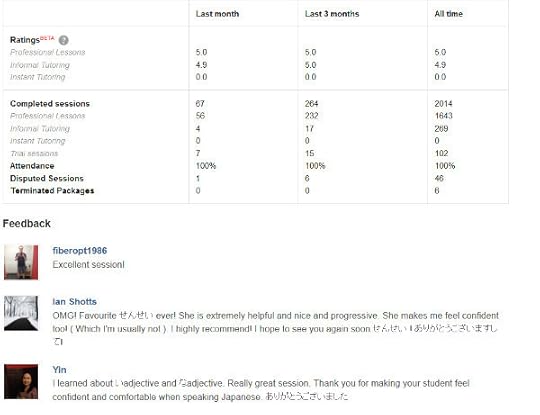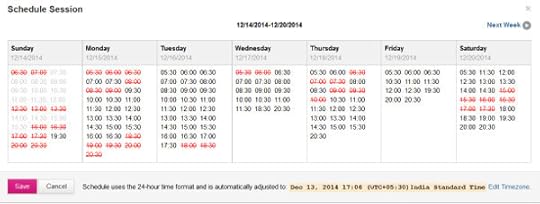Benny Lewis's Blog, page 92
January 9, 2015
Here’s why other countries think you’re weird
One of the main reasons I travel so much is that I find it fascinating to see how different people are across different cultures.
For new travellers, some of these differences can make people from other countries seem completely weird or just plain rude.
Simple things you take for granted as being done in a standard way – like checking into a hotel, greeting a shopkeeper, or ordering food in a restaurant – can have completely different cultural norms from what you’re used to, sometimes leaving you to wonder: “What is wrong with those people?”
Today I wanted to share a few anecdotes I’ve heard from travellers encountering the weird ways other cultures do seemingly standard stuff. I’ll emphasize how funny some of these differences can be, especially when you look at them from both perspectives rather than critique them as “wrong”.
We’ll start with a story my friend Derek Sivers told me about the way hospitality is done in India.
A confused Indian in Finland
 Derek (in his own words):
Derek (in his own words):
In India, you’ll notice that hotels feel over-staffed.
There will be 5 uniformed men standing in the driveway, waiting to open the door of the occasional arriving taxi. There will be 2 men next to them whose job is just to open the door to the lobby. Inside the lobby, there will be a dozen men and women there to greet you and point you in the direction you’re already walking.
They will insist on carrying your bag for you, even if it’s just a little backpack. Politely declining seems to shock and frustrate them. Once you check in, there will be one or two people to walk you to the elevator, press the button for you and bring you to your room, then guide you around your regular little hotel room, showing you where the bed, TV, and toilet is, and how the AC remote control works.
I guess it’s a sign of low cost of labor, especially when you find out it’s cheaper to hire a car with a full-time driver to drive you everywhere, than it is to rent a car and drive it yourself.
So I was having lunch with a successful Indian businessman one day, and mentioned my observation of the over-staffed hotels. Even though he’s a worldly guy, he was sincerely surprised.
“Really? You think so?” He thought about it for a bit, then said something fascinating:
“Actually I had the opposite experience. I was flown to Helsinki Finland once for a conference. They put me up at a nice high-class Hyatt hotel.
I take the taxi from the airport to the hotel, the taxi driver drops me at the door, and there I stand, alone! Nobody around to help me with my bags!
I wondered if perhaps the hotel has gone out of business.
I walk into the lobby, and again, empty! I was starting to get worried until I saw a woman behind the counter at the other end of the lobby.
I tell her my name, she checks me in, then gives me my room key, and tells me to have a nice night. I thought what kind of nonsense is this?
How can a hotel have no staff? Am I just supposed to find the room by myself?
I eventually did, but thought it was outrageous, and mentioned it to the conference organizers the next day. They laughed and assured me that’s how things are done there. So strange.”
—
Derek’s story shows that the weirdness of a country is completely a matter of perspective. From a western perspective, the idea of someone pushing our elevator buttons for us and telling us precisely where inside the bathroom we’ll find the toilet is ridiculous. It’s too much. But for Derek’s friend, the absence of this sort of hospitality left him feeling neglected.
I really appreciate this story, because I distinctly remember arriving in India last month and experiencing exactly what Derek described.
I had just arrived in India, flying in from Indonesia at around 11pm at night. I was exhausted. All I wanted to do was get the key to my hotel room and faceplant into the pillow.
But that’s not what happened. Instead I did indeed have to “endure” the local hospitality, complete with a tour of my room and instructions on how to use the phone. The whole time I was mentally begging the attendant to please leave please leave please leave! and I was left overwhelmed and a little agitated by what I considered to be an excessive and over-the-top greeting for simple hotel accommodation in Mumbai.
Something similar happened to me in Singapore, when the attendant of my rented room listed out and pointed out literally every item in the apartment. “You have 2 forks (shows me the forks), 2 spoons, (shows me the spoons)” and on and on and on until she had covered literally everything we had, right down to the two curtains and two curtain ties. I shit you not.
Luckily we weren’t tired or jetlagged during this particular adventure, so we took it in good humour!
“Weird” restaurant culture

Asking “how are you?”
One of the first conversations I ever had with Lauren when I met her was about how confused she was, from her American perspective, about “something” she was “doing wrong” in restaurants as she travelled through Europe. She told me she kept getting strange looks from people, but couldn’t figure out why.
Ten minutes into lunch with her, I knew exactly why. She would say “Hello, how are you?” enthusiastically to waiters or waitresses whenever they came to they table. And OF COURSE they would give her strange looks as a response. I say “of course” because I benefit here from the European perspective, which screams: Why would she want to know how they are doing?? They just met her!
In Europe, we don’t do that. Questions like “How are you?” are reserved for friends or people who you genuinely want to know how they are doing and what’s going on in their life. If you’re a European just doing your job at the restaurant where you work, having a customer who’s a total stranger ask how you’re doing is just plain weird.
And this is of course a completely different perspective from that of North America, where it’s polite and friendly to ask the question as pretty much a universal greeting!
Beating around the bush
In another example, a Canadian reader told me she was in Berlin in a Starbucks, and wanted to Instagram her coffee. Suddenly the German waiter came up to her while she was getting ready to take the photo and said “Please don’t take photos in our café. Thanks.”
She was horrified by his rudeness!
Of course, in Germany saying that is perfectly reasonable, as Germans tend to be more direct and don’t “beat around the bush” when giving bad news. But in Canada, the norm is to “sandwich” something so “blunt” with pleasantries.
A sensible Canadian waiter would have said, “Hi there, how are you? Everything OK with your mocha? Anyway, no biggie, and I’m really sorry to disturb you, but unfortunately we have a policy of not allowing photos to be taken in our café. I hope you don’t mind! And I’m so sorry about this. Thanks again for coming to Starbucks and enjoy your drink!”
To Europeans like me, this is a mindbogglingly verbose and roundabout way of saying something much simpler.
I, again, can relate to the European perspective here, and I’ve gotten into trouble with some American friends and colleagues for not sandwiching my bluntness! I actually sometimes ask Lauren to “edit” my emails to American companies to soften my language after I once learned the hard way when a very innocent email I sent nearly ended an important business arrangement.
What counts as bad service or good service depends on which side of the pond you’re from
One of my funniest interactions with North American vs European differences was when I used Yelp to find a restaurant in Berlin, and I read a 2 star restaurant review that went something like this:
“….so, I get here and sit down, and then nobody came over to me. I waited several minutes and the waiters just ignored me! I glared at them the entire time and they didn’t flinch. I couldn’t believe it, and I finally had to actually raise my arm and wave them over to give my order! Then, after I finally ordered my food, it took over 20 entire minutes for the food to arrive. When I was finished, no one brought the check and I had to ask for it myself!”
To me, this review is hilarious because from a European perspective, this is an example of perfectly good service!
For my confused American friends, let me explain.
In Europe, the whole experience of eating in a restaurant is that the waitstaff bothers you as little as possible. Meals tend to be a very slow process, and part of the restaurant experience is that you get the table to yourself and call the waiters over when you need them. They expect that if you want something, you’ll tell them. Otherwise, they’ll let you sit there, undisturbed, for hours on end, reading your book and pondering whatever you ponder! So for me, calling waiters over in obvious gestures and waiting 20 minutes for food is completely normal.
Whereas in North America, good service requires that waiters and waitresses double check that you have everything you need as often as possible. They’re supposed to anticipate your needs, for example by bringing you the bill before you even have to ask.
I can also attest after spending a lot of time in America that the food just gets prepared way faster there. I don’t know how they do it. In comparison, restaurants in the UK and Europe are tortoise slow. Lauren actually commented to a British person once, “You know how food is really slow to come out in the UK?” …and he had no idea what she was talking about.
Food service in America is completely different to Europe. Kitchens are well-oiled machines where turnover is as important as quality. And it’s not just “fast food” that’s fast – it’s all restaurants! For my American friends, 15 minutes is a long time to wait for food in a restaurant. Anything over 20 minutes is an outrage.
But on the other side of the pond, 20 or even 30 minutes of waiting for your food to arrive is totally normal!
Now try to imagine the American restaurant experience from the eyes of a foreigner.
This means that Europeans in North America feel very rushed and pestered in U.S. restaurants. I can imagine a European Yelp review of an American restaurant saying something like this:
“… this restaurant is in too much of a hurry. They made the food in a hurry, slamming it on my table 5 minutes after I ordered. After that, my waitress wouldn’t leave me alone! Every 5 minutes she’d annoy me with another question, interrupting an intimate conversation or asking me how my food was while I was chewing! And they brought my bill before I asked for it, basically telling me to hurry up and get out!”
When I’m in America I have to remember not to wave down a waiter/waitress whenever I need something, as this is considered quite rude of the customer (as my ex-waitress girlfriend confirms every time I do it). I have to try not to get frustrated when they interrupt me every 5 minutes to ask how my food is. And I still can’t get used to my bill getting slapped down on the table with a waitress saying “whenever you’re ready hon!” since it feels like I’m getting kicked out.
That’s a formula for unfortunately misplaced Yelp reviews if there ever was one!
And then there’s the whole tipping thing. I’m not even going to try to explain it – so I’ll just refer you to this article instead!
An Indian on car horns in America
Okay, last story (but I could go on and on!)
When westerners first get to many Asian countries, the endless car horns can make it seem like everyone has road rage. Because they do indeed honk their horns all the time.
But it does not mean the same thing as it does when people do it in the west, where it usually means something like “Move out my way, asshole!” or “I don’t like that thing you did just there and this is my way of informing you of that fact!”
 On the contrary. In many Asian countries, like Thailand and Indonesia and certainly India, it’s simply their way of indicating they are doing something, like turning or passing you. So it’s actually an important part of second-by-second communication on the road.
On the contrary. In many Asian countries, like Thailand and Indonesia and certainly India, it’s simply their way of indicating they are doing something, like turning or passing you. So it’s actually an important part of second-by-second communication on the road.
To wrap up, Derek tells us another story he heard from an Indian on this subject:
“I commented to a young programmer in Bangalore India on the cacophony of the ever-beeping horns of every car, truck, and scooter on the roads there. Again, he felt the opposite.
He had just been flown to America for his first time for some consulting work, and said, “Here I was. Chicago! America! It was even rush hour when I arrived. But in the taxi from the airport to my hotel…. silence!
Hundreds of cars, but none of them making a sound! It was eerie! Like a funeral!
Why so silent? What’s wrong? It was hard for me to sleep that night with all that spooky silence.”
—-
From my many years of travelling, I’ve learned to appreciate these cultural differences (or at least try). By looking at my own culture retrospectively, I’ve been able to make cultural adjustments with Parisians, I’ve broken through cultural stereotypes to get to know Germans, Dutch, Japanese, Egyptians, Chinese, and many other cultures… and I’ve picked up quite a few new habits myself!
I suggest you give it a try the next time you travel, and try to imagine how your ways might seem “weird” from the outside perspective.
Share your own funny cultural observations that would seem totally normal from the opposite perspective in the comments below or over on Facebook.
The post Here’s why other countries think you’re weird appeared first on Fluent in 3 months - Language Hacking and Travel Tips.




January 6, 2015
How I got over my fears to finally speak Russian
Today’s post is by Lauren, my partner on the blog and in life! After successfully learning Esperanto last year to get her started in language learning, she has decided to make Russian one of her goals for 2015.
She had a false start at first, that I’m sure many of you can relate to. But then one day she got busy and made it her “day 1″ to speak from. Shortly after she said she’d never be able to do it, she spent 52 entire minutes speaking only in Russian. She didn’t use a single word of English, her first time ever speaking the language!
I was so proud of her, as well as impressed! It just goes to show that such feats are not just performed by experienced polyglots, but also by newbies to language learning. If she can do it, so can you! Here is her account of how she did it.
———–
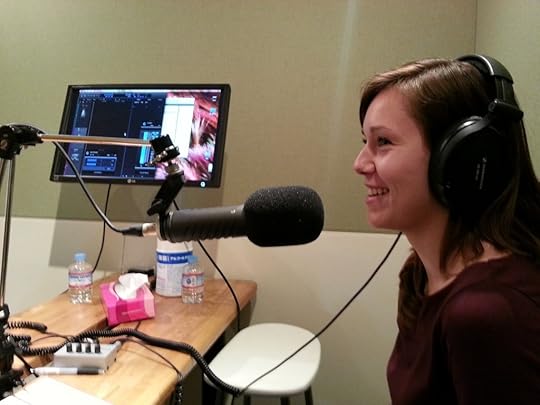
A while back, I decided I wanted to learn Russian. And I decided I was going to learn Russian the “Speak From Day 1″ way, by speaking the language on Skype, from the start, to see what it would be like. Benny talks a lot about how he’s spoken his new languages on the first day, often referencing his famous Polish in 1 hour project, but I still wanted to know what it would be like, what it would feel like (terrifying? easier than I’d thought? a disaster?) for me.
Here I’ll share how I recently started my own Russian project, suffered a false start, but then ultimately had my first conversation with a native Russian speaker – entirely in Russian – after only a few hours of studying phrases.
Learning Cyrillic
I started my project with the intention to speak it right away, so I began creating a “starter script” of the things I thought I’d need to say during my first few conversations. My plan was to decide on the phrases I wanted in English, then translate them to Russian.
 But there was a problem. I didn’t read Cyrillic, and it was useless building a script if I couldn’t read or type in the language. So I put my script aside and studied Cyrillic for a few weeks.
But there was a problem. I didn’t read Cyrillic, and it was useless building a script if I couldn’t read or type in the language. So I put my script aside and studied Cyrillic for a few weeks.
My Cyrillic study went really well, and it was fun to be able to start pronouncing new Russian words by sight. Russian letters look intimidating at first but they’re actually pretty easy to learn.
To learn Cyrillic, I used Memrise and a little book called “Read and Write Russian Script” by Teach Yourself.
Memrise was good for helping me come up with mnemonics for weird-looking letters, but if you are having trouble putting the letters together to read and pronounce bigger words, I highly recommend this little Teach Yourself book. It teaches you letters in the context of actual words, so you’re learning to read Russian, not just memorizing what individual letters sound like.
I read through it and completed all the exercises in 3 sittings, and I have a very short attention span. By the time I was done the book, I could confidently (but slowly) read and pronounce Russian writing.
Overcoming Distractions
After I learned Cyrillic, I got distracted for a few months with work and I sort of… abandoned my Russian project. Shameful, I know.
Part of the problem was that I felt frustrated with developing the starter script I knew I’d need to talk in Russian on Skype. None of the phrase lists I found online or in books were helpful for that purpose. To speak on Skype, I’d need to know how to say “Thank you for talking with me” and “Could you please type that out?” and things like that. And figuring out how to say all of these things correctly in Russian was time-consuming and frustrating.
I solved this problem by enlisting the help of a native speaker. I told her the Russian phrases I wanted to learn in English, and she helped me create Russian versions of them in a cheat sheet! Once I had my Russian phrases, I had no more excuses.
Finding a Russian Teacher
It turned out to be extremely important for me to start out with the right teacher. Because I wanted to use the Speak from Day 1 method, I knew I’d be talking very slowly for a while. This would require an extremely patient language partner.
When I started looking for my first teacher, I went on italki and browsed through all the profiles of the Russian native speakers. There were a lot of them, and it was kind of hard to decide who to choose.
Benny suggested I read their student comments and look for the word “patient,” or to look for reviews from other beginners, and that’s exactly what I did.
But more importantly, I sent out messages to each of my potential teachers and told them I was a beginner, an absolute beginner who is practicing my first few phrases. This was so vital. Some teachers wrote back saying that I wasn’t right for them. Some even told me bluntly that they get impatient with beginners! But this was a good thing – It’s so much better that I find these things out before my first class with a native rather than right in the middle of it.
In the end, I wrote to 5 teachers and only moved forward with 2 of them. Narrowing it down to the right teachers was a really important step for me.
Speaking Russian From Day 1
I scheduled my first Skype conversation with a Russian native three days after I received my list of Russian starter phrases. …And then of course I procrastinated and didn’t actually start studying those phrases until the day of my Skype lesson… so what ended up happening was that I started learning Russian phrases and had my first Russian conversation on the very same day.
Let me tell you about what was going on in my mind all of that morning.
At first, I was confident. I had hours ahead of me! And I had the phrases I needed right there in front of me. How hard could it possibly be just to memorize a simple script?
But as I studied, the words were not sinking in as fast as I’d liked. I realized that it wasn’t as simple as reading words on a page. Even though I do read Cyrillic, I read it slowly, and when I see a word it takes me a few seconds to pronounce it, sound-it-out style.
I started to get very nervous. As it got closer to the time of my Skype call, I started to get seriously cold feet. None of the Russian phrases I was practicing were sticking to memory. It took me several tries to pronounce even a single phrase. I started to realize that I wasn’t going to have memorized nearly any of them. I started thinking, How can I expect another person to listen to me pronounce simple sentences, syllable by syllable, letter by letter? Who on earth has that kind of patience?
At some point I started reevaluating all my life choices. Do I really want to learn Russian? Can I just not learn Russian, even though I told everyone I was going to learn it… and maybe no one will notice? I started daydreaming about ways to get out of this phone call. And finally I told Benny, I’m not ready, I need more time to study, I have to cancel the call.
But of course he talked me out of it. He told me that all of his first sessions always involve him pronouncing words syllable by syllable, too. And that his teacher would always simply wait for him to finish. He promised my teacher would be patient with me.
So I decided maybe I can go through with this thing.
My First Conversation in Russian: What it was like
One of the things that helped me push through my nerves was that my Skype appointment with my Russian partner was only scheduled to be 30 minutes long. And I thought, even if it’s horrible, and my mind goes completely blank, it will be over in a half an hour. I can survive anything for 30 minutes!
And then my Skype call started.
Looking back now, the conversation was really funny.
The first thing that happened was that she spoke Russian to me (of course), which kind of shocked me a little bit for a second. And I did not understand her even a little bit. Not a bit! I had a sort of deer-in-headlights reaction.
Something else that happened is that I learned a lot about what was missing from my starter script. For example, one of the first things she said to me was “Kak dela?” (How are you), and I had somehow managed not to include this phrase or a potential answer in my starter script! How embarrassing. What did I do? I just ignored her question and started saying one of my prepared phrases instead.
And you know what, it was fine! I just decided that I was going to practice the phrases I had prepared, the best that I could.
Because I couldn’t understand anything she said to me, I often asked her to type out what she was saying, and she did. I also used the Russian word for “hold on” a lot, while I put her text into the translator. But I said everything in Russian, which was a huge win.
Some of my favorite moments from the call:
1) She asked me where I live. I have prepared for this! The question of where I live is sort of complicated since we always travel, so to make it easy on myself I prepared just to say New York. We will be living in New York this year, so it’s not that untrue.
So I say “I am from Baltimore, but now I live in New York” in Russian – a phrase I’ve prepared. Yes! And her response is, of course, “Me too! Which part do you live in?” And since I know nothing about New York, I then have to say “I don’t live in New York” in Russian, and totally confuse her, and not be able to explain myself because I don’t have the words. Facepalm.
2) After 30 minutes in, I reminded her that our time was up (I looked that up in Google Translate). She then asks me if I want to continue the lesson. Another deer in headlights moment. I have not prepared for this, and I don’t know how to say “Oh, I thought we were only talking for 30 minutes…” in Russian, and I don’t want to say just “No” out of context and seem rude, so I just say “Da” (yes) and we proceed to talk for another half hour!
In the end, we spoke for 52 minutes. If you ask me how I did it, I would say I really don’t know other than that she was just really patient with me, and I was really patient with myself. We used a translator a lot, and after a while I started to notice certain words being repeated again and again, and she helped me correct my pronunciation on the few words I did know.
It was fun, and honestly it matters a lot that I picked the right teacher. And I’m actually looking forward to our next session 
Week 1 Learning Russian
Here’s everything else I did in Week 1:
After my first conversation, I spent the rest of the week mostly practicing my listening and pronunciation skills with RussianPod 101.
Towards the end of the week, I decided I wanted to expand my study by practicing writing (typing) in Russian, as well as adding variation to my study through a more traditional course.
To practice typing, I started by installing a Russian keyboard into my Mac, and then adding Russian letters to my keyboard. You can buy pretty Russian keyboard stickers on Amazon, but since we’re traveling right now and can’t really order things online, I made mine for free using a sharpie marker and a lint roller.

As for the course I started, I’m trying Assimil right now because next to Teach Yourself, it’s one of Benny’s favorite courses, and also it came highly recommended by a reader who previously learned Russian. But I’ve only just started it, so I won’t include it in the resources for today’s post because I haven’t used it long enough to decide if I really like it.
Moving forward, I plan to alternate my learning time more with mnemonics and other strategies, and I’d also like to learn the lyrics to Let it Go in Russian, because I love singing as a language learning tool.
But most importantly, I will be speaking Russian regularly online as often as I can. Doing this really helps me to make my study time count, because every time I sit down to study I have in my mind that I’m preparing for an actual conversation that I’ll have soon. I’ve found this to be both extremely motivating as well as very useful in that I get to practice what I learn immediately with a native.
What I Learned By Speaking From Day 1
Here are the mistakes I made starting out:
First, I created a WAY overly complicated starter script. I was preparing to use long, perfect phrases like “Could you please type that out?” when for now, all I really need to say is “Type, please?” or even just “Type?” I know now that I’m not going to seem impolite with my teacher when I say this. She clearly sees that I’m a complete beginner struggling to practice simple phrases.
I also had totally unrealistic expectations for what I should be able to accomplish right away. After the call ended, Benny made a big deal about the fact that I talked for 52 minutes, but I kept saying “Yeah, but we talked mostly through translation” or “Yeah, but I didn’t understand her at all.”
But that’s not true. I did understand some things she said towards the end. And I learned several new words, and now I know more about the words I’ll need to prepare for Skype chats in the future. I think it’s really important to recognize these little steps as progress, because they are progress.
So for my next few conversations, my goals are going to be very simple: Use a few new phrases, try to understand a few new phrases, and keep the chat in Russian (which I did do for my first Skype chat, I’m glad to say!) And I really think that’s all I need to ask of myself right now.
Resources
To recap, these are the resources I used to start with during Week 1:
To Study
Memrise
Reading and Writing Russian Script by Teach Yourself
RussianPod101
To Speak with a native:
Italki and Skype
For backup:
Homemade keyboard letters
Google Translate
Russian keyboard for Mac
If any of you have had similar experiences getting over your fears for that first conversation, do share it with us in the comments below!
Oh yes, and if you’re looking to start your own project this week, sign up to the Add1Challenge to get accountability partners to help you through your language project.
The post How I got over my fears to finally speak Russian appeared first on Fluent in 3 months - Language Hacking and Travel Tips.




January 2, 2015
Why Spanish is Easy: Understanding Spoken Spanish
With 2015 upon us and everyone making New Year’s Resolutions, I figured I’d give some love to the most popular second language in the U.S., and the official language in over 20 countries around the world: Spanish.
To do this, recently I’ve been busy behind the scenes asking language learners to share their biggest issues with learning Spanish so I can help demystify the process. I received a huge number of requests for help!
So I set aside some time to work on helping all of you learn Spanish as fast and easy as possible, and I’ve created a new guide called Why Spanish is Easy to help you. It includes tips, hacks and resources to help you fast track your Spanish learning, with encouragement for anyone who may have tried to dip their toes in the language, but found it hard to learn for several reasons.
To celebrate the launch, I’m offering a 30% discount this weekend. That means you can pick up the guide for just $27 (usual price $39). You will need to enter the discount code iwillspeakspanish to get the special offer. Check it out here.
 I know more than anyone what that’s like to struggle with Spanish, considering that Spanish was my first real attempt at learning a foreign language, and I got nowhere with it myself for six entire months before things took off for me. Ultimately I realized that I needed to view the language in a different way, and since I haven’t seen anyone else write about that (even now, 12 years later!), I want to share these ideas myself!
I know more than anyone what that’s like to struggle with Spanish, considering that Spanish was my first real attempt at learning a foreign language, and I got nowhere with it myself for six entire months before things took off for me. Ultimately I realized that I needed to view the language in a different way, and since I haven’t seen anyone else write about that (even now, 12 years later!), I want to share these ideas myself!
But today I’ll also give you a free taste of the new guide right here. So let’s get to today’s blog post which is a segment taken from Why Spanish is Easy guide specifically about how to understand spoken Spanish.
Understanding Spoken Spanish
One of the first thoughts you’ll likely have when you hear Spanish spoken naturally is Why are they speaking so fast?
This was a big problem for me when I first got into Spanish properly. Even if I could read a sentence written out in Spanish and get the gist of it, if someone spoke that same sentence aloud to me, it would be a jumble of noise. What gives?
While I wish I had a magic cure for this problem, the truth is that you need to train your ear to associate Spanish sounds with the written form, and this does take time. But it doesn’t have to take a lot of time.
With just a few weeks of consistent practice, you can train your ear to adapt to the sounds of Spanish.
First you’ll need to get used to the phonetic system and it’s connection to pronunciation. But what do you do to help associate those sounds with actual words? The trick is to ease yourself in through Spanish content that is appropriate to your level.
In my case, in Spain, I found Spaniards speaking at normal speed almost impossible to understand. I was close to giving up when I found that making friends from Mexico and Ecuador (even while in Spain) made a world of difference, because Mexicans and Ecuadorians tend to speak Spanish more slowly.
Next, I highly suggest you try watching telenovelas (soap operas) from places like Colombia. This helped me a lot, since the stories have very simple plots which keep me engaged, while at the same time I get to listen to genuine spoken Spanish. After a few months using this technique I was ready to talk to Spaniards, and now I understand them just as easily.
If possible, try to get your favourite movie or TV series in Spanish. To do this, I generally search for the series on Wikipedia, then click on the left to view the equivalent article in Spanish. There you can find the series’ equivalent name in Spanish, and you can try to get the box set on Amazon.
Alternatively, the original English versionmay come with a Spanish audio option on the DVD (you should be able to find this information on the sales page). If you can’t find it, check out amazon.com.mx or amazon.es, since they are more likely to have media dubbed in Spanish only. This may require international shipping, but it’s not as expensive
as you would think.
Watching a movie or TV series in Spanish that you already know well in English is excellent practice. You already know the story, and often you’ll remember what the characters are going to say. This means you don’t need to try to figure out what’s going on, and you can focus on the words being said in Spanish. I learned a huge amount of Spanish from watching Los Simpson (The Simpsons) on Spanish TV thanks to enabling subtitles in Spanish (not English!) so that I could learn to associate the written form with the spoken form.
If you make friends with native speakers, you should ask for suggestions on their favourite shows and consider watching them originally in Spanish, rather than just watching dubbed versions of American or British shows. This will help you understand more of Spanish culture as well.
Specific resources for learning Spanish
A few other ideas I’d highly recommend:
Listen to Spanish music. You can find many stations in Spanish on tunein.com, or you can Google what songs are in the top 40 charts in your target country. Then find the lyrics (Google the song name with the word “letras” for lyrics) and try to follow along. This blog post by Andrew goes into great detail of how he does this, using Shakira’s Tortura as an example. I find that love songs tend to be sung slower and are easier to follow.
Use a podcast directed at Spanish learners. My favourite by far is Spanishpod101. Although this wasn’t around for me back in 2003, I’ve used this company’s podcasts for my other languages to improve my listening comprehension. I like that it separates language levels according to the CEFR scale. Essentially, it starts at the lowest levels, playing a very brief conversation and explaining every aspect of it, so that when you re-listen to the dialogue at the end of thelesson you understand it much better. As you advance through the levels, it gets
progressively harder and the speakers increase the speed at which they speak. I generally try to aim for one level higher than my current one, to push myself.
Study Spanish audio at different speeds. You can take audio from a naturally spoken podcast, recording of a radio show, or interview and slow it down using the free tool Audacity. Simply import the audio file once downloaded, and then click Effect > Change Tempo. You can also change video speed in VLC (Playback > Speed) or QuickTime (Window > Show AV Options).
You can get audiobooks recorded in Spanish on Audible – their native player on Apple and Android devices allows you to slow down the speed up to 3 times.
My New Guide to Learning Spanish
Yes, Spaniards speak fast, but Spanish can be easy to learn if you think about it in the right way, and if you have the right approach.
The above section is one of many in my new guide to learning Spanish. As you can see, this is not a course in Spanish, but a simple explanation of the hardest parts of learning Spanish with top tips for how to solve those problems.
I hope you’ll check out Why Spanish is Easy. This weekend is the best time to get it – don’t forget to use the discount code iwillspeakspanish for 30% off!
Happy 2015, and Happy language learning!
The post Why Spanish is Easy: Understanding Spoken Spanish appeared first on Fluent in 3 months - Language Hacking and Travel Tips.




December 30, 2014
How to Make a New Year’s Resolution and Actually Keep It
Every year around January 1st, my inbox gets filled up with language learners excitedly declaring to me their New Year’s resolutions. They tell me, this is the year I will learn French! Learn Spanish! Learn Chinese!
To all you resolved language learners out there, hoping to make 2015 the year you finally reach your language-learning goals, I’d like to offer a bit of guidance in making your New Year’s resolutions and actually keeping them.
To do this, I’ll share my own goals for 2015 with you – both those I have for my languages, but also my other goals as well – and I’ll tell you exactly how I plan to achieve them. The strategy is the same for both.
“BAD” NEW YEAR’S RESOLUTIONS TO AVOID
Generally, most people’s New Year’s resolutions tend to revolve around the same themes. Here are some examples, that are all technically things that I want to do in 2015:
Read more.
Exercise more.
Eat healthier.
Learn to swing dance.
Perfect my French.
Speak Chinese better.
These are all bad goals to have, mainly because each one lacks specificity. This is a general theme with New Year’s Resolutions, and it’s why I don’t even use the term myself, and always prefer to model my life improvements around goals.
I’ve talked about this before, but it bears repeating: To reach your goals, you have to actually have a goal. You need an end-point that you can visualize and know for sure whether or not you’re on track, and when you’ve achieved it.
If your goal is to improve your French, how will you know when you’re done? If you want to read more, how will you know if you’re on track? Have you reached your goal if you read for 1 day? For 30 days? How can you gauge your progress?
The trick to making a New Year’s resolution that actually sticks to is to visualize your resolutions in concrete terms. Here are some examples.
MY 2015 NEW YEAR’S GOALS
To show you what I mean, here are several of my own genuine goals for 2015, all of which are much more specific versions of the vague “resolutions” above:
Read 60 books by November.
Run a half marathon by March.
Run a full marathon by November.
Restrict pasta, chocolate and sodas to 1 day per week (Saturday only)
Be ready to swing dance confidently as a very solid beginner by November.
Take a mock C2 (mastery level) exam in French by July.
Reach B2 (fluency) in Mandarin by November.
Tip 1: Create goals that are specific and measurable
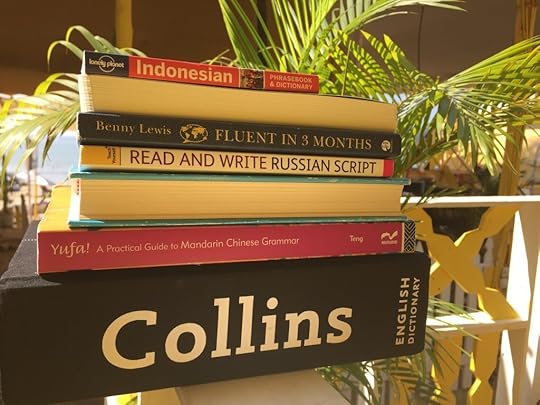
One reason I like the word “goal” over resolution is that it has a idea of measurement behind it. A goal is something that can be reached – something I can check off my list and know exactly when I’ve reached it.
Note how each of the goals I’ve chosen is both specific and measurable. There’s no way to be unclear about whether or not I’ve read 60 books. I’ve either run a half marathon or I haven’t. But “read more” and “exercise more” are nebulous and quite useless because of this.
You will also notice that (apart from the weekly eating restriction) all of my goals have a specific deadline. December tends to involve travel and time with family, so if I am taking on a longer-term goal (as you can imagine I prefer three month goals…) then it ends in November at the latest.
Tip 2: Allow yourself to feel a sense of accomplishment and progress
 Each of the goals I’ve created means something real to me. For example, when I say I want to learn the basics of swing dancing, I say this because I’ll be attending a wedding in November and I hope to be able to swing dance at the reception.
Each of the goals I’ve created means something real to me. For example, when I say I want to learn the basics of swing dancing, I say this because I’ll be attending a wedding in November and I hope to be able to swing dance at the reception.
Do I expect to be amazing at it? Do I want to compete at world-competition levels? No. Not for now at least. I just expect to be able to dance well in a casual setting. This is a realistic goal, especially since I will be living in multiple places and can only realistically get a few classes per month.
Maybe for 2016 or 2017 I can have more hefty goals like training for dance competitions, but realistically dancing at a specific wedding is all I want to care about for now, and that will make further improvement much easier.
In my running goals, I’ve also included two separate benchmarks. First a half-marathon, then a marathon. I’ve broken this up into separate milestones so that I can feel progress in the smaller wins, rather than focusing only on the biggest possible endpoint.
If you’re a member of my email list, you know that I ended 2014 by taking a mock C1 exam with my French teacher, and that I’ve decided to make fluency in Chinese a priority for this year.
I’ve been studying French for years and this goal is a single point on a much longer road.
Imagine if, when I started studying each language years ago, my goal was just to “learn French.” I still wouldn’t be there! Instead every language project I’ve ever had has been based on milestones.
Tip 3: Know your limitations and don’t let setbacks derail your momentum
One of my goals, for example, is to eat healthier, but I’ve chosen to measure my progress here by allotting one day a week as “cheat day”. For me, Saturday is cheat day. And I know that if I eat a gnocchi or a chocolate lava cake on any other day except cheat day, then I haven’t met my goal for that week.
But when that happens, I don’t just throw the whole plan out the window, because cheat day comes around every single week. Every week I’ll still have my Saturday cheat day looming over me, holding me accountable, giving me another chance to succeed.

Don’t expect yourself to be a super hero. Don’t give yourself unrealistic expectations like “stop eating chocolate”, because when you inevitably give in to temptation, you’re likely to give up your goal entirely because you’ve already “failed.”
My goal of “running a half marathon” might also be an unrealistic goal for me if I was a total newbie at running. Pretty much every successful marathon runner I’ve come across has had smaller milestones.
For instance, the picture at the top of the post is me getting ready to run my first ever 5K last year in Valencia. It took me two whole months to train myself to be able to run that much more modest distance, and I was exhausted at the end of it!
I’ve since pushed my boundaries up to running 10k, then running the same distance and feeling great afterwards and continue to improve my endurance and speed, so that a half-marathon within 3 months is realistic.
When you make your goals measurable, you can recognize your progress rather than your failures, and use that to keep up your momentum. Celebrate all the weeks that you make progress. Focus on your wins!
USE TOOLS TO TRACK YOUR PROGRESS
The tools you use to recognize your progress will make a huge difference in your success. Having looming reminders, social competitions and other psychological motivators help a lot. Here are my favourites!
Language goals
My current favourite social tool for language learning is Memrise because I find the daily/weekly/monthly scoreboard to be an excellent motivator. This tool is great if you have a specific number of words you want to memorize, with of course the excellent mnemonics that help you remember. Follow me here.
Overall To-Do’s
 I use Lift for my daily to-dos. I like this tool because I can search for specific daily tasks that may be key to my longer term goal, that an entire community has grown around, and I can tick each daily task from my smartphone.
I use Lift for my daily to-dos. I like this tool because I can search for specific daily tasks that may be key to my longer term goal, that an entire community has grown around, and I can tick each daily task from my smartphone.
You can follow me here (keeping in mind that December is my month off  ) or check out the plan for language learners I made for that site here. I have public goals I don’t mind others seeing for social feedback, and can make other goals private.
) or check out the plan for language learners I made for that site here. I have public goals I don’t mind others seeing for social feedback, and can make other goals private.
Pretty much every goal you can imagine has a community around it on that site!
Reading goals
Goodreads is by far the best community for sharing reading goals, with the most in-depth reviews of books. Once you track enough books read on the site, it starts to give you exceptionally good recommendations based on your interests. People like your updates (you even update progress within books and how far you are in each one you are reading) and can send you personal recommendations.
I keep my Goodreads up to date on what I’m reading. Follow my profile here!
Exercise goals
I use Endomondo to track my jogs, and help me plan how much I should run to realistically reach my goal, based on my past progress. Then when I run, I have my smartphone with me and my speed and distance are tracked automatically through GPS updates.
HERE ARE TEAM FI3M’S 2015 GOALS – WHAT ARE YOURS?
This January, I still want my inbox to be filled with language learners sharing their goals with me, but this year I’d like to hear more about specifically what level you’d like to achieve and why, and how you plan to get there.
To give you even more inspiration, here are the New Year’s resolutions of some other members of Team FI3M. Share your own in the comments!
Balint

Read 100 books
Reach C1 level in German and pass the exam
Reach solid B2 conversation level in Spanish
Go to the most Northestern point of Europe by car
Simplify my life a bit more every week
Finish another Ironman (if my back allows)
Joseph

Read 50 books
Do physical activity at least 3 times per week
Double the amount of money that I put into savings
Lauren

Run a 5k
Cook my way through Alton Brown’s repertoire (at least 20 recipes)
Learn the basics of swing dancing
Reach B2 level in Esperanto
Reach B1 level in Russian
Reach A2 level in French
Kittichai

Learn at least 1,800 Joyo Kanji
Read 10 books in Japanese
Exercise at least for 30 minutes, 3 times a week.
Wake up before 6:30 am
Go to the beach!
David

Paint the dining room (we’re aiming to have this finished on Jan 1!)
Paint & new carpet in the guest bedroom
Paint & new carpet in my office
Fully clear my wife’s new allotment & eat vegetables grown on it.
Spend at least one weekend in complete silence
Read an average of 1 book per week (52 books)
Now it’s your turn! What are your goals for 2015? How can you adjust your goals to be measurable, or to create milestones to measure your progress?
The post How to Make a New Year’s Resolution and Actually Keep It appeared first on Fluent in 3 months - Language Hacking and Travel Tips.




December 13, 2014
How to find the right teacher for online language lessons
One of the most frequent questions I get when I talk about my intensive language projects is how do I find a good teacher?
Today I want to cover this question in as much detail as possible, as part of my Skype language lesson series of posts. The previous post was how to prepare for Skype Language Lessons.
Why a Skype based language teacher?
Note that when I say “Skype”, I mean video/audio calls over the Internet in general. You can work with online language teachers through Google+ and many independent systems, but I’ll say Skype in these posts for simplicity.
There are numerous reasons why I opt-for Skype based lessons over in-person lessons, but the major ones are:
It doesn’t require living in the country
It is dramatically cheaper than in-person private lessons, because you can leverage currency differences if your target language country has a currency that’s weaker than your home country’s. It is also amazingly cheaper than in-person group lessons in many cases!
It requires zero travel time for both the teacher and the student. For instance, when I got private lessons in person in Taipei (in Mandarin), as well as being expensive, it was time consuming since the most affordable teacher I could find was 45 minutes travel by public transport each way.
You can have audio only or video based calls, as you prefer (connection permitting). This is a little easier for people who feel intimidated by having someone see them stumble through as a beginner learner
You can utilize all the tools available to you online, such as quick dictionaries or translators in another window while you chat. More on this in another post, but I use these kind of tricks to help me get speaking from day one more easily than I would with a teacher sitting in front of me.
Sometimes I have in-person lessons, but 99% of my spoken practice nowadays in all my foreign languages is via Skype. With that being said, let’s see how to find those teachers!
Start with italki to find online language teachers to choose from
Italki is the website I use to find all my language partners and teachers.
There are many great places to find just the right teacher for you. I’ve used a bunch of different resources, but always come back to italki. Compared to the competition, I find that italki [eye-talk-ee]:
Has way more teachers who are active, so you are more likely to get responses. Some other sites tend to have unresponsive teachers.
Have a wider range of languages. There are some OK alternatives for specific languages out there, but if you aren’t learning Spanish or Chinese you run out of options quickly. italki has these and many more.
Has a time-zone automatically adjusted calendar of availabilities. You don’t need to do any calculations to account for time zones – italki does that for you. Every other site I’ve used has a huge pain-in-the-ass process of figuring out what time it is for who.
Includes reviews for teachers – like ebay or Amazon, you can see what your teacher is like before spending money on them. We’ll be using that feature below to help us decide who to go with!
Has social forums and places to write questions and answers built it. Teachers and language learners alike are very active in the forums there, and you can follow certain posters whose questions or answers you like.
Plus, using the site is easy. You just log in and create an account. Play around with the free options, see if a free language exchange works for you, or use the question and answers feature to ask quick things about your target language. If you’re ready for a class, follow these instructions:
Make sure your language-learning profile is filled out completely
As well as trying to find the best teacher for you, the best teachers get enough requests that they themselves can be picky about their students! In this case it helps to have your profile filled out completely – add in a photo, a nice summary about your language learning needs, details of where you are and your language levels.
Deciding to use a Professional or Community teacher
Italki has several different options for teachers, and the two main ways of separating paid teachers are based on pricing and experience.
Professional teachers can only be placed in this category if they demonstrate a background in education to the site. These teachers either have a teaching certificate or they have verifiable experience as a language teacher. They generally have a few years of experience, and have taught off the site in language schools, universities, or privately.
Informal tutoring is everyone else. These people may be native speakers of the language they teach, or even experienced learners. They may have extensive teaching experience online, but don’t have any offline credentials. In some cases they may be new to teaching online.
Because of the professional background, the first category tend to be more expensive, especially for certain languages. But if you have a spoken focus to your approach, I actually find that informal tutoring is absolutely fine for beginner to intermediate levels. It’s your chance to talk to a native speaker, and that practice can be more important than speaking with someone who can explain technical aspects of the language to you. Some informal teachers are really fun and easy to chat to.
But from Intermediate level and up, I’d almost exclusively go for Professional teachers. To really get up to the C-level mastery stages, you need someone who can push you, and you generally need to tweak things like grammar and academic issues at this stage, which become much more important than they would be for beginners. An experienced teacher can explain complicated grammar rules to you, whereas a native speaker with no teaching background may not have any idea how to explain the structure behind their language, or even be aware what the structure is!
In some less common languages though, the selection of teachers may be slimmer and you may have to go to a category that is more expensive, or with teachers with less experience than what would be ideal. If you can’t find any teachers of your target language, then a great option is to search for other learners you can practise with, instead of native speakers. As a beginner, this practice will be a great help! As long as you are practising, you are going to be helping your progress. But how to choose the right teacher?
Selecting your new language teacher from many options
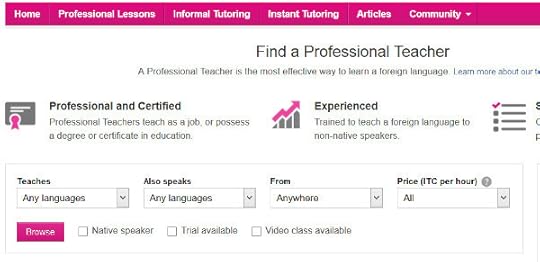 So you’ve decided whether or not a community or professional teacher is right for you. Here’s how to narrow it down from there.
So you’ve decided whether or not a community or professional teacher is right for you. Here’s how to narrow it down from there.
Select your target language in “teaches”. As for the “also speaks” category, I generally ignore it, because I only want to speak my target language with this person – no English! Many professional teachers tend to speak English, but there are plenty of extremely affordable community teachers who may not speak English well. This is great because you have to speak the target language with them.
The From field is useful if you want to focus on particular dialects. For instance, when I wanted to learn Egyptian Arabic (which technically isn’t a dialect), I selected “teaches” as Arabic and “From” as Egypt. To brush up on my Quebec French, I select French and Canada. Spanish from Spain or from Argentina, Portuguese from Portugal or Brazil – it’s great to be able to choose your dialect!
When you search, it’s important to note that the order of teachers in the list is based on who has logged in most recently. It has no bearing whatsoever on ratings or what teacher might be better than the others. This is a great thing to keep in mind because I find that teachers who haven’t logged in for a week or more are way less likely to reply.
As such, I’d open the first 5-10 teachers in new tabs and see who has the most interesting profiles. What I’m looking for is…
Is their rating 5.0 or very close?
Have they completed more than just a few sessions?
Do they attend all their sessions, or have many disputed sessions or terminated packages?
What wording do people use in the feedback.
The tone of the feedback doesn’t concern me as much as the actual content. For instance, if someone complains “My teacher refused to say anything to me in English, and wasn’t interested in talking about grammar” then this is a good point for me. If a teacher doesn’t let a single mistake go by, this is a plus for me if I’m intermediate, but a big problem if I’m a beginner.
As a beginner, the biggest drawing point for me is the word “patient” in a teacher’s profile. That’s what I need when I’m just starting out and butchering the language. I need a teacher who will sit patiently while I force out every last syllable.
Once I’ve found a few promising profiles, I actually choose several teachers (not just one!) and see if I can book a session with them.
Booking your first online language lesson
I like to book my “first” session with several teachers so I can get a feel for which works best for my approach. In addition to patience, I like a teacher who actively seeks out new conversation topics, so I don’t have to. If I’m a beginner in a language, my mind is processing so many things, and I don’t want the extra work of having to think of what to say next. For me, good teachers keep the conversation flowing, while still making sure that I’m doing lots of talking.
Teachers tend to have several different styles of lessons they offer. Sometimes they follow a particular programme that may involve correcting homework, and charge a little more for this due to the extra demand on their time. Sometimes they segment the classes based on levels or topics, and even on the amount of time per session.
Personally, I prefer 30 minute lessons, but some teachers only offer 1 hour lessons. If it’s my first class with a teacher, I’ll just select a single session, but if the class goes well, I’ll book a package since that ends up being cheaper in the long run.
Pick the session type you are interested in, and try to schedule a session. If you are new to the site, you also get a couple of test sessions that last 30 minutes with some teachers (and these are usually really cheap!)
One of the final criteria that has unfortunately eliminated otherwise perfectly good teachers is do their availabilities work for me? Because you are dealing with different countries, that teacher may only be available while you sleep, or while you work.
As I mentioned before, the site adjusts automatically to your local timezone, which is a huge load off your mind with international time issues. You just need to make sure that you’ve input your own timezone accurately into the settings. Then you simply pick a time slot that is convenient for you (always has to be at least 24 hours from now), and write a personal message to the teacher, stating what you hope to learn with them.
The personal message is important. Tell the teacher what level you’re at and what you want to do during the lesson. This will give him or her that final chance to make sure they’re the right teacher for you.
Submit the request (you should have credit in your account before you do this) and see if they reply! If they do, then get ready for that class (message them if necessary to see if there is something you can study in advance to prepare for your class), and you’ll be speaking before you know it 
How to know if a teacher is “good”
Once you’ve had your first conversation, you should be feeling pretty great. After you’ve had a few sessions, you’ll start to get the feel for the different styles of different teachers, and you’ll notice that some tactics worked well for you, and others didn’t.
What makes a teacher “good” is subjective, but here’s my personal opinion.
When I’m a beginner:
I like a teacher who will patiently wait for me to finish my sentences, no matter how long it takes me!
I like a teacher who keeps up the conversation. For instance, if I say “I’m in India,” they might ask “How is the weather in India?” I don’t to feel like I’m struggling to move the conversation forward.
If a teacher pauses for a while and then says something like “So… what do you want to talk about?” That’s an almost instant indication that this person isn’t for me. Engaging teachers are good at taking every little thing you say and expanding on it to bring the conversation forward.
And I like my teachers to have a good gauge for my level and to adjust accordingly. If a teacher sees I’m a struggling beginner and still talks very fast, uses complicated vocabulary, or corrects my grammar constantly, then I will usually make a mental note that they’d be good to revisit later when I’m more advanced.
When I’m more advanced:
This is when I like my teachers to be a little stricter. At this stage, a good teacher to me is one who doesn’t let my mistakes slide by. At this stage, I like the teachers to speak at a more native speed. And I especially look for Professional teachers who implement good conversational or grammar exercises that push me out of my comfort zone.
At the mastery stage, I like to debate complicated or controversial topics with my teacher – malnutrition, deforestation, gay marriage – and the best teachers come up with these exercises for us to complete together, and rollplay.
——
There you have it – my guide to finding the best language teacher for you. I’ll make sure to expand on what I do during my sessions in the next post in this Skype-lesson series!
How do you choose your teacher on italki? What is a “good” language teacher to you? Let me know in the comments!
The post How to find the right teacher for online language lessons appeared first on Fluent in 3 months - Language Hacking and Travel Tips.




December 9, 2014
A Month Living in Ubud, Bali, Indonesia [Travel Update]
This past month, I have expanded the list of countries I’ve lived in by one (I’ll be doing it again early next year, more on that later!), and today I am happy to tell you all about my experience in Bali, Indonesia.
I’d never been to Indonesia before, which looking back on, is hard to believe since it fits all my criteria for the kind of places I like to live in.
It’s cheap, the locals are friendly, the weather is beautiful, and it also happens to have arguably the easiest natural language in the world to learn (which I did spend a little time learning). But in this post, I want to tell you a bit about my experience of the culture and daily life in this beautiful country, and how I spent my time living for a month in Bali, Indonesia.
Living In Bali

By the way, I consider myself as having “lived” in a country if I have been there for at least a month, and if I am living in the kind of accommodation in which I could host other people if I wanted to. So far, for me that’s been two dozen countries, and my stay in Bali definitely hits those criteria, as you can see from the spacious flat I had all to myself…sort of…
Because every day new and interesting wildlife would spring up into our living space and become part of our daily existence. Have you ever found a spider creeping around your bedroom, and had trouble falling asleep at night? Well, it was kind of like that, but instead of spiders it was mosquitos, dragonflies, moths, thousands of ants, bees, wasps, endless lizards (both small and large), and other creepy crawlies too varied to count. And a couple of birds and even a bat flew in too.
Here’s my “pet” Lizzie the lizard (a gecko about a foot long), clearing away a little of my bug problem:
A video posted by Benny Lewis (@irishpolyglot) on Nov 11, 2014 at 1:15am PST
If you can see, our apartment had no significant separation between “inside” and “outside.” It has windows and doors you can open or close to moderate how much air flows through, but the apartment itself was built with openings to the outside throughout.
To keep from being eaten alive at night by mosquitos, though, our bed was fitted with a very nice mosquito net that really felt like a sanctuary, a place where we we could safely protect ourselves from the interesting night-time nature that surrounded us.

Except one night, when an insect that must be like the Indonesian equivalent to the Cicada came out in swarms so thick that you can’t help but get a few in your mouth. Don’t worry though, my trainer at the gym told me that as a kid his favourite snack was those little nuisances fried! They were everywhere.
Your Door is Always Open
This “open door policy” didn’t extend just to the nature, but also to the neighbours. One of the locals told me that in Bali, there is an “open invitation” for other people to come into your home, which I discovered several times when I’d come home to find my neighbours inside my apartment, or when we’d be lounging on the couches only to be surprised by the landlord literally popping into our living room via the window (he had been climbing around on the roof shingles, doing some repairs, and wanted to be able to walk down our steps with his paint can).
This took some getting used to, but it’s just part of the mentality and lifestyle of the Balinese. And of course, we never worried about our safety or the safety of our possessions because…
The Balinese people are incredibly friendly
Once I left my keys in my motorbike, and when I came back a kind stranger had put them hidden from public view, but still easily accessible to me, knowing that I’d look for them!
And when I rented it, I just paid the monthly fee (about $50) and drove off in it. The guy who rented it to me didn’t care to ask for an ID, security deposit… or even my name or where I was staying! He just trusted that a month later I’d give it back to him.
One thing that made meeting people go smoother, is that remembering their names is childsplay. , so the firstborn is “Wayan”/”Gede”/”Putu”, second is “Made”/”Kadek”, third is “Nyoman”/”Komang”, and fourth is “Ketut”. Pretty much everyone you meet will have one of those names!
And in Indonesian, rather than say “you”, you refer to another person through their position relative to you, and this is a great way to feel closer to them. Mas’ is a friendly term for contemporary male, and this essentially means “brother”. You might also hear ‘Bapak’ (father) when a young person speaks to a male who’s clearly older or has higher position. Everybody is family!
Ubud is incredibly cheap
I often spent no more than $5.00 for two people on each meal, including drinks, tax and service charge. And this was without really even trying to keep it cheap. If we had actively sought out low-cost spots, or if we were on a mega-tight budget, we could easily have kept things even cheaper.
One nice quality about the restaurants in Ubud is their tendency to use recyclable materials whenever possible. A side-effect of living on an island, I suppose. The straws were metal and were washed and reused (when they were given out), and even the salt and pepper shakers were made out of leaves or wood.


There’s also no shortage of cheap, but beautiful, accommodation in Bali. While I was there, the local Balinese kept asking me “Where are you staying?” And when I answered, they’d grill me about its amenities and tell me about somewhere they know that’s better. Does it have a pool? No, no pool. Oh, my friend’s place is much better, it has a pool. Next time, you’ll stay there, yeah?
Bali may be cheap, but at first glance, it doesn’t look that way…
Become a millionaire in Bali, on arrival!

Every single time I went to the ATM, I got to proudly say “I’m a millionaire!”
In the photo above, I’m holding one million Indonesian rupiah. This may sound like enough to buy your own fleet of helicopters, but it’s actually a much more modest €65 / $81 / £51. This means that you have a LOT of zeros to deal with, no matter what you are buying.
So a 1.5L bottle of water is 2,500Rp. Yikes! Sounds expensive, until you realize that’s about…. 20 cents. 
Driving in Bali is an adventure
Like in many other countries in Asia, indicator lights and caution are thrown out for honking. Honk if you want to turn, honk if you want to overtake someone, honk if you are turning a corner and want anyone coming the other way to know you are coming. Honk, honk, honk!
And of course, the motorbike (which incidentally, in Indonesian is “sepeda motor”, where sepeda is one of many loan words in Indonesian, in this case coming from the French vélocipède, an older word for bike, where just “vélo” is preferred nowadays) being the main mode of transport means that you quite regularly fit your whole family, your dog and your cargo of bambo sticks on board. Lauren and I joined in on this madness and drove our bike while holding a full-sized swivel fan.
Lane dividers are more like suggestions than enforceable rules. At any given moment, there are people barrelling down at you, headed the wrong way in your lane, and you just have to trust that they’ll swerve out of the way. In fact, at all times you need to be prepared to swerve around pedestrians, other motorists, and endless stray dogs and chickens (the chickens just roam the streets – I don’t know how their owners keep track of them), and kamikaze frogs.
But there really is an organization to the chaos. Knowing that there is always going to be something in your way keeps you much more alert, and I actually got to like the honking system. The fact that people swerving in an out of lanes meant that everyone gets to move at their own pace. You can go as slow, (or as fast), as you want to, and you don’t have to worry about anyone getting impatient that you’re holding up traffic. They’ll simply send you a friendly beep from behind that signals “Don’t move, I’m passing to your right,” and go on about their day. I don’t remember seeing a single speed limit sign the entire time I was there.


The petrol stations are a lady sitting by a shelf lined with bottles of oil. If you look closely at the picture, you’ll see that the petrol containers are actually re-purposed Vodka bottles!
—————
We really enjoyed our stay! While Indonesia is a huge country with plenty to discover, and even Bali itself has everything from a mountain to diving joys, we were happy to chill out in Ubud for the month after a year of moving around so much. But with the rainy season coming in, it was time to find a new home, and for this month we are in the south of Goa in India.
I’ll travel around a little and hope to have a nice update about my Indian experience to add to the amazing time I had here on the last trip, before we visit our next country in January.
Let me know your thoughts on this post in the comments!
The post A Month Living in Ubud, Bali, Indonesia [Travel Update] appeared first on Fluent in 3 months - Language Hacking and Travel Tips.




December 5, 2014
Dictionary Giveaway: 12th Ed Collins English and Ultralingua app
Who wants a free dictionary?
Collins, who have been into dictionary publishing since 1819, were very kind to send me their brand new 12th edition Collins English dictionary which is the largest single-volume English dictionary in print. As you can see in the photo, it’s pretty big!
This edition has more than 50,000 newly added entries, totalling over 722,000 words, meanings and phrases. Apparently “adorkable” is a word, and I only know this because I saw it while taking this photo.
I would love to hold on to it, but being the nomad that I am, I simply can’t add this extra weight to my baggage, so I’m giving it away to a lucky reader.
How To Win
Just write a comment below telling me your funniest, most ridiculous, or most interesting story involving a dictionary. This can be anything from that time that Google Translate told you your mother was a juggling orang-utan, or simply when the dictionary at the back of a phrasebook helped you make a new friend, or even a made-up story about how the Portuguese pocket dictionary in your breast-pocket saved your life from a sniper, thus leading to you becoming the vice-president of Brazil. A panel of extremely biased judges, all of whom are me, will pick the winner on Tuesday and ship it to you anywhere in the world.
And since I expect to see several interesting stories, there will be 10 runner up prizes!
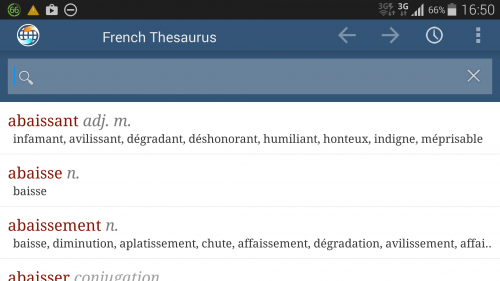
Collins have also given me voucher codes for Ultralingua, by far the most extensive smartphone dictionary app around. From the one app, you can install a multitude of dictionary databases, only from the highest quality sources. It has other features like verb conjugation, click through extra details with example sentences, and all other fun stuff you’d expect from a good dictionary.
The app itself is free, but you pay for the individual dictionary installations. If your story is really good, you could be among the top 10 runners up who will get a voucher, each one of which lets you download five dictionaries from their database.
They can be monolingual dictionaries for English or French, a thesaurus for English or French, and bilingual dictionaries for Esperanto-English, Spanish-English, Mandarin-English, Portuguese-English, German-English, Italian-English, Russian-English, Latin-English, Dutch, English, French-English, French-English Medical, German-Italian, Spanish-German, Spanish-Italian, Spanish-Portuguese, French-German, French-Spanish, French-Italian, French-Portuguese, Italian-Portuguese, Dutch-German, Dutch-Spanish, or Dutch-French.
If you win, you can pick any 5 of these that tickle your fancy! Just download the free app and I’ll send you the code to activate 5 downloads.
Looking forward to seeing your stories 
The post Dictionary Giveaway: 12th Ed Collins English and Ultralingua app appeared first on Fluent in 3 months - Language Hacking and Travel Tips.




November 28, 2014
Sale: Cyber Monday Mega-Deals for Language Learners!
This Internet is ripe with wonderful offers this weekend during the “Black Friday” rush of deals that you’ll get before Christmas, and Team Fi3M has been searching for the best sales relevant to language learning just for you. Enjoy today’s wide selection of the best of the best in language learning resources and in prices for those resources! Most of these deals are only good this weekend so get them quick! 
The Internet’s best language learning deals
I’ve collaborated with all of the companies below to get you the best possible deal for the Black Friday weekend. I have used resources from each company and can confirm that it is quality stuff that is worth the investment, especially when it’s on offer. Click the links below and you’ll get a better deal than anywhere else (discount codes are added in automatically only through these specially made links, and you’ll support Fi3m through affiliate connections – thanks!)
Innovative Language Podcasts: 51% off subscriptions
I have tried out several language learning podcasts, but have found that the Innovative Language series stands out as the best quality for almost every language. I can recommend all of the ones below, as they follow the same format of separating their lessons into levels that follow the CEFR scale pretty closely. This lets you ease yourself in as a beginner, but discard the lessons as they get too easy and move on to harder ones.
This format has been great to help me move up a level – I recommend pushing yourself and listening to the level higher than where you are now! You’ll never find it boring this way, and always be challenged, but learning. Each podcast is made more fun with entertaining presenters and culturally relevant topics.
I also had the chance to visit their main office in Tokyo, and I can confirm that the people behind the company are great, and very passionate about language learners. When you sign up to their course for the language you are learning and see the English news edition, you’ll find an interview they had with me back in February/March with my best tips for beginners.
Click the podcast website below relevant to your target language, and enjoy! With the discount implemented in these links you get 51% off the normal price for any subscription. This is an especially good deal for their longer-term subscriptions – well worth it considering the consistent fun podcasts uploaded in each language.
Most popular languages:
Other languages in alphabetic order:

























Amazon Kindle E-readers up to 40% off
 Believe it or not, my favourite language learning tool (that I use every day!) is my Kindle Paperwhite.
Believe it or not, my favourite language learning tool (that I use every day!) is my Kindle Paperwhite.
I am subscribed to Le Monde, Die Zeit and El País newspapers, and I have the Send to Kindle plugin in my browser for any foreign article I like the look of online. Then when on my Kindle, the language of what I’m reading is automatically recognized (great for a polyglot who wants to learn multiple languages!) and if I click any word that I don’t recognize, it gets translated instantly, even when offline 
Note that you need to buy the appropriate dictionary first (usually just a couple of dollars). For my best languages, I don’t use the bilingual dictionaries but the French-French, German-German and Spanish-Spanish dictionaries instead. I learn while I read, and the Kindle (unlike my computer screen) is designed to be very easy on the eyes and the resolution makes it look like a normal book.
Having said that, I got my Paperwhite a year ago for about $160. Now the newer version is on sale for $99. And the cheapest device, simply called “the Kindle”, also with a touch screen is only $49. Highly recommended that you get your hands on one this weekend before the price goes back up.
Otherwise, when you are ordering your language learning books for Christmas, or the upcoming New Year’s Resolution rush, make sure to have Kindle Prime to get all your language books priority shipped to you to arrive within two days.
Skritter – Chinese/Japanese character learning app: 33% off
 In my first Chinese project, I just wanted to learn how to speak it. But now that I’m doing long term gradual improvement, I of course want to learn how to recognize and write Chinese characters. And lucky for me, Skritter has just come out with its Android app (the iPhone app has been around for much longer).
In my first Chinese project, I just wanted to learn how to speak it. But now that I’m doing long term gradual improvement, I of course want to learn how to recognize and write Chinese characters. And lucky for me, Skritter has just come out with its Android app (the iPhone app has been around for much longer).
I’ve been testing it out and absolutely love it – it makes learning the characters so much more interesting than those tedious books that have empty spaces for you to copy the initial character template, using swipe technology on your phone to make it more interactive. In my case, I’m not as concerned with stroke order, so I can turn such things off to customize it to be how I like it. And of course, it works for Chinese Hanzi traditional and simplified and Japanese Kanji.
It’s a great tool that makes you feel like you’re holding a magic wand as you practice characters, implements the spaced repetition system and has loads of other features. And until Monday, Skritter is 33% off. Enjoy the offer by clicking the link above to have the discount code applied automatically.
Glossika: 30-40% off

 Mike (a.k.a. Glossika on Youtube) is a fellow polyglot and one I collaborated with in the Skype Me Maybe music video, as well as during my Chinese project when we made a video chatting in Mandarin together. He is best known on Youtube for sounding exactly like he was born and raised in Taiwan, even though he is a westerner. He also heads a series of language courses, that are actually designed to be used to intensively learn a language to fluency in 3 months!
Mike (a.k.a. Glossika on Youtube) is a fellow polyglot and one I collaborated with in the Skype Me Maybe music video, as well as during my Chinese project when we made a video chatting in Mandarin together. He is best known on Youtube for sounding exactly like he was born and raised in Taiwan, even though he is a westerner. He also heads a series of language courses, that are actually designed to be used to intensively learn a language to fluency in 3 months!
I’ll be testing them out myself and reviewing them on the blog soon! In the mean time, just until Monday his well established products are on sale at 30% off, and a series of new languages are getting released on Monday, so you can buy them at the pre-release price of 40% off, only this weekend. Click the Glossika link to find out.
——–
Do you know of any other goodies on sale for language learners this year? Please share your favorites in the comments! I hope you enjoy these language learning special offers 
The post Sale: Cyber Monday Mega-Deals for Language Learners! appeared first on Fluent in 3 months - Language Hacking and Travel Tips.




Sale: Black Friday Mega-Deals for Language Learners!
This Internet is ripe with wonderful offers this weekend during the “Black Friday” rush of deals that you’ll get before Christmas, and Team Fi3M has been searching for the best sales relevant to language learning just for you. Enjoy today’s wide selection of the best of the best in language learning resources and in prices for those resources! Most of these deals are only good this weekend so get them quick! 
First, Fi3M’s own pride and joy:
Fi3M Premium: 50% off
Fluent in 3 Months Premium will be on sale this weekend for HALF off – $47! Premium has everything you need to become a fast-track language learner – including video courses, language immersion resources and in-depth guidance on finding native speakers to practice with. This weekend only it’s available for $47 – half-price but all the same great content. Click here to get Fi3M Premium 50% OFF. This promotion starts today and ends on Cyber Monday!
When you sign up, my team will email you personally to welcome you and to give you a bonus virtual goodie bag of language learning freebies for everyone who signs up to Fi3M Premium this weekend. You’ll see it in your welcome email!
The Internet’s best language learning deals
I’ve collaborated with all of the companies below to get you the best possible deal for the Black Friday weekend. I have used resources from each company and can confirm that it is quality stuff that is worth the investment, especially when it’s on offer. Click the links below and you’ll get a better deal than anywhere else (discount codes are added in automatically only through these specially made links, and you’ll support Fi3m through affiliate connections – thanks!)
Innovative Language Podcasts: 51% off subscriptions
I have tried out several language learning podcasts, but have found that the Innovative Language series stands out as the best quality for almost every language. I can recommend all of the ones below, as they follow the same format of separating their lessons into levels that follow the CEFR scale pretty closely. This lets you ease yourself in as a beginner, but discard the lessons as they get too easy and move on to harder ones.
This format has been great to help me move up a level – I recommend pushing yourself and listening to the level higher than where you are now! You’ll never find it boring this way, and always be challenged, but learning. Each podcast is made more fun with entertaining presenters and culturally relevant topics.
I also had the chance to visit their main office in Tokyo, and I can confirm that the people behind the company are great, and very passionate about language learners. When you sign up to their course for the language you are learning and see the English news edition, you’ll find an interview they had with me back in February/March with my best tips for beginners.
Click the podcast website below relevant to your target language, and enjoy! With the discount implemented in these links you get 51% off the normal price for any subscription. This is an especially good deal for their longer-term subscriptions – well worth it considering the consistent fun podcasts uploaded in each language.
Most popular languages:
Other languages in alphabetic order:

























Amazon Kindle E-readers up to 40% off
 Believe it or not, my favourite language learning tool (that I use every day!) is my Kindle Paperwhite.
Believe it or not, my favourite language learning tool (that I use every day!) is my Kindle Paperwhite.
I am subscribed to Le Monde, Die Zeit and El País newspapers, and I have the Send to Kindle plugin in my browser for any foreign article I like the look of online. Then when on my Kindle, the language of what I’m reading is automatically recognized (great for a polyglot who wants to learn multiple languages!) and if I click any word that I don’t recognize, it gets translated instantly, even when offline 
Note that you need to buy the appropriate dictionary first (usually just a couple of dollars). For my best languages, I don’t use the bilingual dictionaries but the French-French, German-German and Spanish-Spanish dictionaries instead. I learn while I read, and the Kindle (unlike my computer screen) is designed to be very easy on the eyes and the resolution makes it look like a normal book.
Having said that, I got my Paperwhite a year ago for about $160. Now the newer version is on sale for $99. And the cheapest device, simply called “the Kindle”, also with a touch screen is only $49. Highly recommended that you get your hands on one this weekend before the price goes back up.
Otherwise, when you are ordering your language learning books for Christmas, or the upcoming New Year’s Resolution rush, make sure to have Kindle Prime to get all your language books priority shipped to you to arrive within two days.
Skritter – Chinese/Japanese character learning app: 33% off
 In my first Chinese project, I just wanted to learn how to speak it. But now that I’m doing long term gradual improvement, I of course want to learn how to recognize and write Chinese characters. And lucky for me, Skritter has just come out with its Android app (the iPhone app has been around for much longer).
In my first Chinese project, I just wanted to learn how to speak it. But now that I’m doing long term gradual improvement, I of course want to learn how to recognize and write Chinese characters. And lucky for me, Skritter has just come out with its Android app (the iPhone app has been around for much longer).
I’ve been testing it out and absolutely love it – it makes learning the characters so much more interesting than those tedious books that have empty spaces for you to copy the initial character template, using swipe technology on your phone to make it more interactive. In my case, I’m not as concerned with stroke order, so I can turn such things off to customize it to be how I like it. And of course, it works for Chinese Hanzi traditional and simplified and Japanese Kanji.
It’s a great tool that makes you feel like you’re holding a magic wand as you practice characters, implements the spaced repetition system and has loads of other features. And until Monday, Skritter is 33% off. Enjoy the offer by clicking the link above to have the discount code applied automatically.
Glossika: 30-40% off

 Mike (a.k.a. Glossika on Youtube) is a fellow polyglot and one I collaborated with in the Skype Me Maybe music video, as well as during my Chinese project when we made a video chatting in Mandarin together. He is best known on Youtube for sounding exactly like he was born and raised in Taiwan, even though he is a westerner. He also heads a series of language courses, that are actually designed to be used to intensively learn a language to fluency in 3 months!
Mike (a.k.a. Glossika on Youtube) is a fellow polyglot and one I collaborated with in the Skype Me Maybe music video, as well as during my Chinese project when we made a video chatting in Mandarin together. He is best known on Youtube for sounding exactly like he was born and raised in Taiwan, even though he is a westerner. He also heads a series of language courses, that are actually designed to be used to intensively learn a language to fluency in 3 months!
I’ll be testing them out myself and reviewing them on the blog soon! In the mean time, just until Monday his well established products are on sale at 30% off, and a series of new languages are getting released on Monday, so you can buy them at the pre-release price of 40% off, only this weekend. Click the Glossika link to find out.
——–
Do you know of any other goodies on sale for language learners this year? Please share your favorites in the comments! I hope you enjoy these language learning special offers 
The post Sale: Black Friday Mega-Deals for Language Learners! appeared first on Fluent in 3 months - Language Hacking and Travel Tips.





November 26, 2014
What can you do in 4 hours? Benny’s first Indonesian class
Inspired by Moses McCormick’s unfiltered uploads, I’ve decided to share an unedited crucial moment in my language learning processes; both the first time I’ve ever spoken the language and my first ever class.
What I did was study four hours over 2 days last week, starting from absolute scratch, and then on day 2 of studying I met up with Daniel Prasatyo, the Academic Director at the Cinta Bahasa language school in Ubud/Bali. (Cinta is pronounced “Chinta”)
I spoke English when I arrived to see the school real quick, and then as soon as we sat down, I set up my camera and recorded over an hour of our class together, trying to speak as much Indonesian as I could. We did use English for a segment of the class, as he explained some sentence structure to me, but the very start and most of the second half of our class was mostly in Indonesian, following with my “Speak from the start” philosophy 
Sorry the video ends abruptly – it was 3 minutes before we stopped the class and my battery ran out. I also had to wait almost an entire week to upload this video, because Gigabyte-large HD files are not so much fun to upload when most of your Internet is 3G! Of course, don’t forget to activate Youtube subtitles. I’ve also uploaded a scan of the notes Daniel was writing for me, to help anyone watching the video.
Enjoy!
//www.youtube.com/watch?v=zVNVSFZnrmY
The post What can you do in 4 hours? Benny’s first Indonesian class appeared first on Fluent in 3 months - Language Hacking and Travel Tips.













